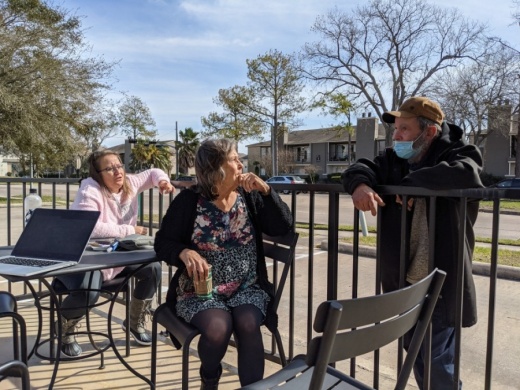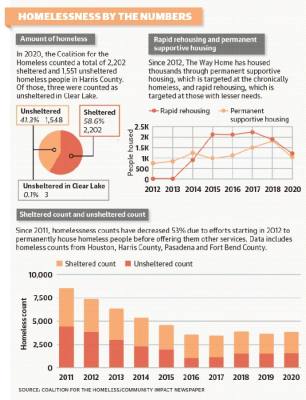The man approached where Rains-Moran was sitting with her daughter, Danielle Rains. Despite the medical mask covering half his face, the man was immediately recognized as Troy, one of the more than 100 homeless people in the Clear Lake area the women know.
“This is the hub of our homeless,” Rains-Moran said, referencing the area around the intersection of I-45 and El Dorado.
Troy, who is known by other homeless people for having only three toes on one foot, mentioned his foot was hurting. Rains took the time to remove his shoe and change his bandages before sending Troy on his way.
Rains-Moran and Rains are known as “mamas” to the homeless people of Clear Lake. They run the 2,400-member Facebook group Revitalize Clear Lake, which aims to address issues adversely affecting quality of life, including homelessness.
Since December 2019, the two local residents have noticed a steady growth in the number of homeless people in the area, and they both do their best to get to know the local homeless population and help them as best they can. That help can be anything from giving them food to hiring them to clean up trash in an area to driving them to the hospital, the women said.
But it is not enough. The women and other residents feel forgotten and neglected by Houston services and want to see a greater effort made to address the homeless population in Clear Lake, which can bring other problems, such as prostitution, drugs, theft and violence, they said.
“We have a larger homeless group than anybody’s aware of,” Rains-Moran said. “We have a need, and it is spreading. If we don’t stop it where it is, it’s gonna get worse.”
Growing problem
Every year in January, the Coalition for the Homeless, a group that oversees dozens of homeless agencies in Houston and Harris County, conducts a point-in-time count of the homeless people across the Greater Houston area. While recent point-in-time counts show a 53% decline in the number of homeless people in the Greater Houston area since 2011, locals said they have noticed an increase in Clear Lake.
Shelley Villarreal, who runs another Facebook advocacy group called Reclaim Clear Lake, said she has seen the homeless population almost double from around 50 in late 2019 to over 110 today.
“Really, for the past year, we’ve seen the population explode,” she said. “It’s growing.”
Villarreal believes homeless people have success panhandling in the affluent areas of Clear Lake, which encourages them to stay. Additionally, the local drug scene draws the chronically homeless to the Clear Lake area; many area homeless people are addicts, Villarreal said.
Harris County Precinct 2 Commissioner Adrian Garcia, who has made efforts to help the homeless as both a Houston City Council member and Harris County sheriff, said “aggressive” efforts made to address homelessness in downtown Houston may have pushed the population to the edges of town, including Clear Lake.
“I think their issues are valid,” Garcia said of Clear Lake residents’ concerns over growing homeless populations.
Gayle Nelson, the executive director of Family Promise of Clear Creek, a nonprofit that helps homeless families, also concluded the problem is worsening.
In 2020, the nonprofit helped 17 families totaling 57 people, which was double the number the group helped in 2019. Nelson said the nonprofit helps the “hidden homeless”—those who are too ashamed and afraid to admit to anyone they need help—and that COVID-19 is a big reason for the increase.
“People weren’t finding the resources out there that they needed to survive,” she said. “And now it’s coming back again.”
The 2021 point-in-time count has not been officially unveiled, but officials said there may have been a small decrease compared to the count of 3,974 last year. However, in 2020, three homeless people were counted in the Clear Lake area, which is a fraction of the more than 100 residents know in the area.
To count homeless people, the coalition drives around areas where homeless people regularly congregate, such as underpasses and bridges. However, it is not uncommon for homeless people to bolt at the sight of approaching strangers, which could be one of the reasons the coalition’s count may be much lower than the true count, Rains-Moran said.
Additionally, many homeless people hide away during the day and come out at night, but counts are done during the day, Rains-Moran said.
Feeling forgotten
One of the challenges of addressing Clear Lake’s homeless population is that most services and shelters are located 20 miles away in downtown Houston. Star of Hope, SEARCH Homeless Services, the Salvation Army, and dozens of other programs and organizations dedicated to eradicating homelessness are based where officials say homelessness is most prevalent: inside Loop 610.
“All the big guns are downtown,” Villarreal said. “Consequently, most of their case workers and their staff are downtown dealing with that group.”
However, Clear Lake’s residents are not seeing the benefit of their tax dollars at work addressing homelessness in their own community, Villarreal said. The result is residents feel forgotten and that no one is truly working to address the homelessness epidemic in Clear Lake, residents said.
“We’re taxpayers too,” Villarreal said. “We want some services.”
One of the keys to addressing homelessness is meeting homeless people where they are. Homeless people will not necessarily want to move to where services are, said Thao Costis, president and CEO of SEARCH Homeless Services, the lead homelessness case management service in Houston.
“Someone from Clear Lake is not gonna wanna come into downtown, and vice versa,” she said. “People wanna stay where they’re familiar—where they know somewhat what’s around them.”
While discussing this problem with Rains-Moran and Rains, Troy agreed.
“My home is this end of Houston, not that end,” he said, pointing toward downtown.
Nelson said Family Promise of Clear Creek was formed to supplement the lack of city services dealing with homelessness. The Bay Area is too far from both Houston and Galveston to get the true resources it needs to address the problem, so nonprofits have to fill the gap, she said.
“We’re kind of in no man’s land,” she said. “We have a huge need in our community to serve.”
Still, she is encouraged; since COVID-19 hit, local nonprofits have banded together like never before to step up to the challenge of homelessness.
“Even though we don’t get the needs filled like larger cities do, our community is pretty spectacular in wanting to help and ... do something to help another person,” Nelson said.
Calling for change
Villarreal has sent petitions to Garcia, Houston City Council District E Member Dave Martin and other leaders across the area in an effort to address Clear Lake homelessness. The petition demands a designated case worker to connect with and provide resources, transportation and services for Clear Lake’s homeless population.
“We need a person,” Villarreal said. “We have a population that has gone unaddressed.”
Garcia said he is aware of the petition and welcomes the advocacy.
Rains-Moran and Rains agreed the area needs a dedicated case worker to establish trust and a relationship with the area’s homeless. Many homeless people in Clear Lake have mental issues that could be addressed with treatment, they said.
A dedicated social worker in the area could help the homeless population access such care, but Clear Lake is being ignored in favor of downtown, Rains said. Homeless groups said the homeless problem is worse downtown, which is why many services are concentrated in that area of the city.
“Why can’t we have an intake officer that is being proactive?” Rains-Moran said.
The two women have already seen how things can change for the better: Through their efforts, they helped one homeless person, Jimmy, secure a job transporting dogs across the country. He is now off the streets, thanks in part to people taking the time to address his needs, Rains-Moran and Rains said.
“That was our first success story,” Rains-Moran said. “It was like, ‘Wow, this worked.’”
“We gave him back his self-respect,” Rains added.
Homeless organizations have also seen positive change in recent years.
In 2012, The Way Home was started to coordinate the many homeless services across the region under one umbrella. Since then, The Way Home, directed by the Coalition for the Homeless, has taken a “housing first” approach to dealing with homelessness, meaning homeless people are put in apartments before they are offered support services.
The result is a 53% reduction in homeless people counted during annual point-in-time counts since 2012, said Catherine Villarreal, the director of communications for the Coalition for the Homeless.
“Since 2012, I have seen ... lightning speed of people’s ability to move from the street into a home and stay into a home,” Costis said.
Additionally, Houston, Harris County and donors last summer pooled $65 million in resources to increase The Way Home’s permanent housing program. The goal is to house 5,000 homeless people over the next two years, and 700 have been housed since October, Catherine Villarreal said.
“The reason we’re so focused on permanent housing is because we know it works,” she said.
Rains-Moran and Rains were encouraged when they joined the coalition for the 2021 homeless point-in-time count in Clear Lake. The coalition made an effort to meet homeless people where they are and sign them up for services to seek help, and after 14 months of working to help the homeless, Rains-Moran and Rains found the coalition’s efforts encouraging.
“I wanted to cry; I was so happy,” Rains-Moran said. “It gave us a lot of hope.”







